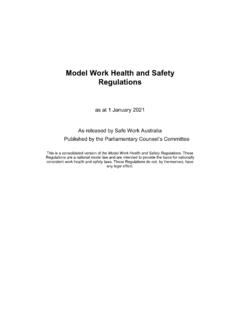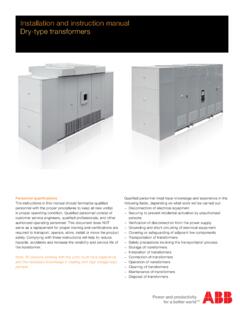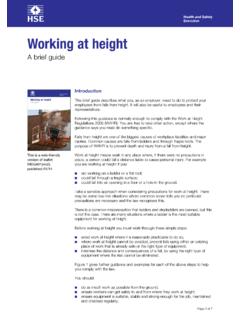Transcription of Guide To Managing Risks of Tree ... - Safe Work Australia
1 1 safe work Australia Contact Information Email | Web OF .. WHAT IS TREE TRIMMING AND REMOVAL work ? .. WHO SHOULD USE THIS Guide ? .. WHO HAS DUTIES UNDER THE LAW? .. HOW CAN Risks OF TREE TRIMMING AND REMOVAL work BE MANAGED? .. WHO IS INVOLVED? .. INFORMATION, TRAINING, INSTRUCTION AND SUPERVISION .. work .. WORKSITE COMMUNICATION .. FOR ACCESSING TREES .. ELEVATING work PLATFORMS .. CLIMBING A TREE .. OTHER METHODS .. work NEAR OVERHEAD ELECTRIC LINES .. AND EQUIPMENT .. WOOD CHIPPERS .. STUMP GRINDERS .. CHAINSAWS .. POLE SAWS .. POWERED HEDGE TRIMMERS .. MANUAL TASK Risks .. FELLING .. FELLING TREES WITH CHAINSAWS .. CLEAR FELLING .. CONTROLLED DIRECTIONAL FELLING .. SECTIONAL FELLING .. AND EMERGENCY PLANNING .. INFORMATION ..44 Guide TO Managing Risks OF TREE TRIMMING AND REMOVAL WORK978-1-76028-771-9 [PDF] 978-1-76028-772-6 [DOCX]2 JULY 2016 Guide TO Managing Risks OF TREE TRIMMING AND REMOVAL WORK1.
2 INTRODUCTIONThis Guide provides information on how to manage Risks associated with tree trimming and removal range of terms are used across the arboriculture industry including lopping, trimming, pruning, thinning, felling and removal. This Guide uses tree trimming and removal work to cover the range of terms used in industry and the work Health and Safety (WHS) What is tree trimming and removal work ?Tree trimming and removal work includes lopping, pruning, trimming, repairing, maintaining and removing amenity trees as well as ground operations relating to tree work like wood chipping, stump grinding and root trees are trees with recreational, functional, environmental, ecological, social, health or aesthetic value rather than for production Who should use this Guide ?This Guide assists duty holders including arborists, tree climbers, horticulturalists, gardeners, tree workers, landscapers, builders, developers and others involved in the amenity tree industry manage their obligations under the WHS does not apply to commercial forestry or work done in relation to growing and Managing forests.
3 Guidance on forestry and growing and Managing forests is in the General Guide for Managing Risks in forestry operations and Guide to growing and Managing Guide is also useful for workers and helps to ensure the health and safety of other people who may be affected by tree trimming and removal work including members of the specific information on the requirements to manage the Risks from falls, machinery and other hazards associated with tree trimming and removal work like noise and hazardous manual tasks is available on the safe work Australia 2016 Guide TO Managing Risks OF TREE TRIMMING AND REMOVAL Who has duties under the law?Everyone in the workplace has a work health and safety duty. The main duties are set out in Table 1 Duty holders and their obligationsWhoDutiesA person conducting a business or undertakingA person conducting a business or undertaking (PCBU) must ensure, so far as is reasonably practicable, that workers and other people are not exposed to health and safety Risks arising from the business or tree trimming and removal work this includes ensuring, so far as is reasonably practicable, the.
4 Provision and maintenance of safe plant safe use, handling, storage and transport of plant provision of an emergency plan provision and maintenance of safe systems of work , and where a fall -arrest harness is used, provision and testing of emergency procedures including rescue PCBU who has management or control of a workplace must ensure, so far as is reasonably practicable, the means of entering and exiting the workplace and anything arising from the workplace is without Risks to health and PCBU involved in the management or control of plant at a workplace has a duty to ensure, so far as is reasonably practicable, the plant is without risk to the health and safety of any , manufacturers, importers and suppliers Designers, manufacturers, importers, and suppliers of plant including machinery likely to be used in tree trimming or removal work must ensure, so far as is reasonably practicable, the plant is without Risks to health and safety.
5 This duty includes carrying out testing and analysis as well as providing specific information about the , such as company directors, have a duty to exercise due diligence to ensure the business or undertaking complies with the WHS Act and Regulations. This includes taking reasonable steps to ensure the business or undertaking has and uses appropriate resources and processes to eliminate or minimise Risks including those from tree trimming and removal work and plant used at the and othersWorkers and other people at the workplace must take reasonable care for their own health and safety, co-operate with reasonable policies, procedures and instructions and not adversely affect other people s health and 2016 Guide TO Managing Risks OF TREE TRIMMING AND REMOVAL How can Risks of tree trimming and removal work be managed?The following steps should be used to decide what is reasonably practicable to ensure workers and other people are not injured when carrying out tree trimming and removal Find out what could cause harm.
6 The following can help identify potential hazards: Observe the workplace to identify how work will be carried out. Consider the physical work environment; equipment; materials and substances used; work tasks and how they are performed; and work design and management. Hazards associated with tree trimming and removal work can include: tree hazards see Visual tree assessment slips, trips and falls manual tasks lifting, pushing, pulling, repetitive movements, holding machinery contact with energised overhead electric lines or underground services crush injuries, entanglement, cuts and abrasions from the incorrect use or lack of maintenance of machinery chainsaws, wood chippers and stump grinders being struck by vehicles or mobile plant moving on or working near the work site falling objects punctures and cuts from tree branches allergic reactions to trees and poisonous plants, and biting or stinging hazards including ants, bees, wasps and snakes.
7 Ask workers about problems they have found at the workplace. Discuss the Risks in carrying out tree trimming and removal work with the operators of cranes or other machinery you may be using at the site. Talk to manufacturers, industry associations, suppliers and health and safety specialists and review incident and injury records including near tree assessmentThe integrity of a tree is critical to the safety of those working in, under and around it. Before working on or accessing a tree by any method, a thorough visual assessment of the tree should be carried out by a competent person. The assessment should consider hazards, condition, wind loading, structural integrity and location. This assessment should form the basis of a site-specific risk assessment and decision-making on whether the tree is safe to access, the method chosen to access the tree and the safe systems of work to be used on the 1 shows many of the conditions which could result in serious risk if they are not identified prior to starting work .
8 5 JULY 2016 Guide TO Managing Risks OF TREE TRIMMING AND REMOVAL WORKF igure 1 Tree hazards2. Assess the risk. In many cases the Risks and related control measures will be well known. In other cases you may need to carry out a risk assessment to identify the likelihood of somebody being harmed by the hazard and how serious the harm could be. A risk assessment can help you determine what action you should take to control the risk and how urgently the action needs to be carrying out a risk assessment think about: The stability and integrity of the tree: Is the tree decayed or dead and unsafe to climb or be attached to? Is the species or the particular tree susceptible to branch failure when under load? Is the tree stable in the ground? Is the crown of the tree leaning heavily in one direction? Is the tree suitable to be climbed? Ensure that no person, plant or thing will come within an unsafe distance of an overhead electric line.
9 Ground surface condition including type of soil, underground services, underground tanks, leach drains and gradients of ground surface. Maintenance of plant and equipment. Access by people and management of traffic. Animal and insect management are there insects or other animals in the tree that may be a risk to a worker? Workers being trained including in emergency procedures , working near overhead or underground services, use of equipment, work tasks and on-site communication. 6 JULY 2016 Guide TO Managing Risks OF TREE TRIMMING AND REMOVAL work Action plans about hazards and the nature of the work including number of workers, each worker s role and job process after discussion with workers. Weather conditions including heat, humidity and wind speed are suitable to start the job and are monitored to ensure they are suitable to continue working. Common hazards like vines, creepers in crown, nails and wire are identified and removed or controlled.
10 Personal protective equipment (PPE) is fit for purpose and, where appropriate, in accordance with the relevant Australian Standard. Establishment of exclusion Take action to control the risk. The WHS laws require a business or undertaking to do all that is reasonably practicable to eliminate or minimise ways of controlling Risks are ranked from the highest level of protection and reliability to the lowest. This ranking is known as the hierarchy of risk control. You must work through this hierarchy to manage first thing to consider is whether hazards can be completely removed from the workplace. For example, carry out the work from the ground as this eliminates the risk of falls and issues with tree it is not reasonably practicable to completely eliminate the risk then consider the following options in the order they appear below to minimise Risks , so far as is reasonably practicable: Substitute the hazard for something safer redesign the work process so less hazardous equipment, materials or quantities are used; use plant specifically designed to lift a person like an elevating work platform (EWP) to gain access to the tree rather than climbing the tree.

















